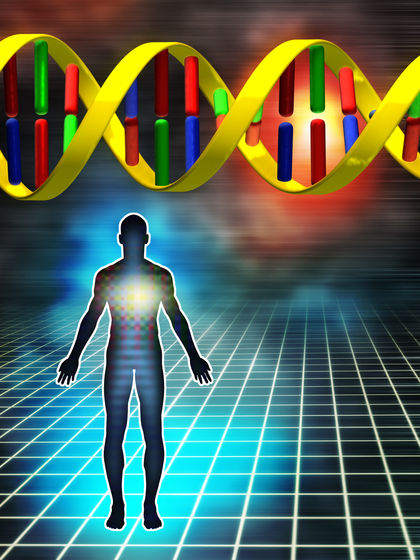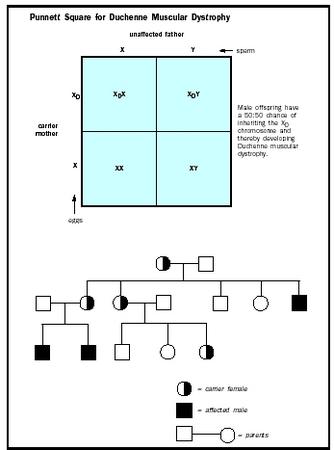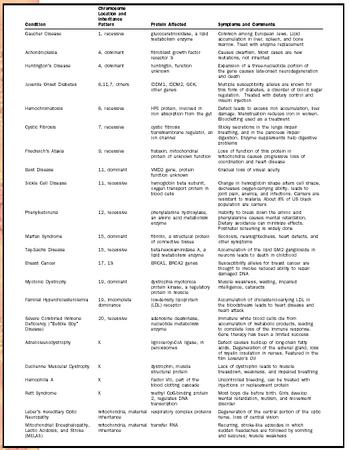Genetic Diseases

A genetic disease is due to a faulty gene or group of genes. While not all gene defects cause disease, many do. New genetic diseases are discovered every month; as of 2001, there are estimated to be approximately 1,100 genetic diseases.
How Gene Defects Cause Disease
A gene is a recipe for making a protein . Proteins control cell functions, and defects in the instructions for making a protein can prevent the cell from functioning properly. Genes are made of deoxyribonucleic acid (DNA), a chemical composed of units called nucleotides , and are carried on chromosomes within the cell nucleus . Most genes are present in pairs (corresponding to the two sets of chromosomes inherited from one's parents). As well as coding for proteins, genes are the hereditary material. Therefore, genetic diseases can be inherited.
Genetic defects cause diseases in a variety of ways. The simplest way is through a "loss-of-function" mutation. In this type of defect, a change in the DNA nucleotides prevents the gene from making protein, or prevents the protein from functioning once it is made. Genetic diseases due to loss-of-function mutations are very common, and include cystic fibrosis (which affects the lungs and pancreas), Duchenne muscular dystrophy, and the hemophilias, a group of blood-clotting disorders.
A second mechanism for causing disease is called a "toxic-gain-of-function" mutation. In this type of defect, the gene takes on a new function that is harmful to the organism—the protein produced may interfere with cell functions, or may no longer be controllable by its normal regulatory partners, for instance. Many degenerative diseases of the brain are due to this type of mutation, including Huntington disease.
More complex mechanisms are possible. Most traits are multifactorial, meaning they are determined by many different genes. In the human population, there are several variants (alleles) of most genes, each form of which

Disease can also be caused by chromosome abnormalities rather than gene defects. Down syndrome is due to having three copies of chromosome 21, instead of the normal two copies. It is likely the extra protein from the extra gene copies lead directly to the disease symptoms, but this is not yet clear.

| Condition | Chromosome Location and Inheritance Pattern | Protein Affected | Symptoms and Comments |
| Gaucher Disease | 1, recessive | glucocerebrosidase, a lipid metabolism enzyme | Common among European Jews. Lipid metabolism enzyme accumulation in liver, spleen, and bone marrow. Treat with enzyme replacement |
| Achondroplasia | 4, dominant | fibroblast growth factor receptor 3 | Causes dwarfism. Most cases are new mutations, not inherited |
| Huntington's Disease | 4, dominant | huntingtin, function unknown | Expansion of a three-nucleotide portion of the gene causes late-onset neurodegeneration and death |
| Juvenile Onset Diabetes | 6,11,7, others | IDDM1, IDDM2, GCK, other genes | Multiple susceptibility alleles are known for this form of diabetes, a disorder of blood sugar regulation. Treated with dietary control and insulin injection |
| Hemochromatosis | 6, recessive | HFE protein, involved in iron absorption from the gut | Defect leads to excess iron accumulation, liver damage. Menstruation reduces iron in women. Bloodletting used as a treatment |
| Cystic Fibrosis | 7, recessive | cystic fibrosis transmembrane regulator, an ion channel | Sticky secretions in the lungs impair breathing, and in the pancreas impair digestion. Enzyme supplements help digestive problems |
| Friedreich's Ataxia | 9, recessive | frataxin, mitochondrial protein of unknown function | Loss of function of this protein in mitochondria causes progressive loss of coordination and heart disease |
| Best Disease | 11, dominant | VMD2 gene, protein function unknown | Gradual loss of visual acuity |
| Sickle Cell Disease | 11, recessive | hemoglobin beta subunit, oxygen transport protein in blood cells | Change in hemoglobin shape alters cell shape, decreases oxygen-carrying ability, leads to joint pain, anemia, and infections. Carriers are resistant to malaria. About 8% of US black population are carriers |
| Phenylketonuria | 12, recessive | phenylalanine hydroxylase, an amino acid metabolism enzyme | Inability to break down the amino acid phenylalanine causes mental retardation. Dietary avoidance can minimize effects. Postnatal screening is widely done |
| Marfan Syndrome | 15, dominant | fibrillin, a structural protein of connective tissue | Scoliosis, nearsightedness, heart defects, and other symptoms |
| Tay-Sachs Disease | 15, recessive | beta-hexosaminidase A, a lipid metabolism enzyme | Accumulation of the lipid GM2 ganglioside in neurons leads to death in childhood |
| Breast Cancer | 17, 13 | BRCA1, BRCA2 genes | Susceptibility alleles for breast cancer are thought to involve reduced ability to repair damaged DNA |
| Myotonic Dystrophy | 19, dominant | dystrophia myotonica protein kinase, a regulatory protein in muscle | Muscle weakness, wasting, impaired intelligence, cataracts |
| Familial Hypercholesterolemia | 19, imcomplete dominance | low-density lipoprotein (LDL) receptor | Accumulation of cholesterol-carrying LDL in the bloodstream leads to heart disease and heart attack |
| Severe Combined Immune Deficiency ("Bubble Boy" Disease) | 20, recessive | adenosine deaminase, nucleotide metabolism enzyme | Immature white blood cells die from accumulation of metabolic products, leading to complete loss of the immune response. Gene therapy has been a limited success |
| Adrenoleukodystrophy | X | lignoceroyl-CoA ligase, in peroxisomes | Defect causes build-up of long-chain fatty acids. Degeneration of the adrenal gland, loss of myelin insulation in nerves. Featured in the film Lorenzo's Oil |
| Duchenne Muscular Dystrophy | X | dystrophin, muscle structural protein | Lack of dystrophin leads to muscle breakdown, weakness, and impaired breathing |
| Hemophilia A | X | Factor VIII, part of the blood clotting cascade | Uncontrolled bleeding, can be treated with injections or replacement protein |
| Rett Syndrome | X | methyl CpG-binding protein 2, regulates DNA transcription | Most boys die before birth. Girls developmental retardation, mutism, and movement disorder |
| Leber's Hereditary Optic Neuropathy | mitochondria, maternal inheritance | respiratory complex proteins | Degeneration of the central portion of the optic nerve, loss of central vision |
| Mitochondrial Encephalopathy, Lactic Acidosis, and Stroke (MELAS) | mitochondria, maternal inheritance | transfer RNA | Recurring, stroke-like episodes in which sudden headaches are followed by vomiting and seizures; muscle weakness |
Inheritance Patterns in Genetic Disease
Genetic diseases are heritable, meaning they may be passed from parent to child. A disease gene is called recessive if both copies of the gene must be defective to cause the disease. Loss-of-function mutations are often recessive. If the second copy of the gene is healthy, it may be able to serve adequately even if the first copy suffers a loss-of-function mutation. In this case, the carrier of the disease gene will not have the disease.
All humans are thought to carry a number of such defective genes. Close relatives are likely to carry similar genes and gene defects, and are therefore more likely to bear children with recessive genetic diseases if they mate. Because of this, a prohibition against marriage of close relatives is found in virtually every culture in the world.
A disease gene is called dominant if inheriting one copy of it causes the disease. Toxic gain-of-function mutations often create dominant genes, as in the case of Huntington disease.
If having one defective gene causes a different condition than having two, the gene is called incompletely dominant. In familial hypercholesterolemia, having two disease genes leads to very high blood cholesterol levels and death in childhood or early adulthood. Having one disease gene and one normal gene leads to less-elevated cholesterol and a longer but still reduced life span.
Most genes are carried on autosomes, the twenty-two pairs of chromosomes that do not determine sex. Males and females are equally likely to inherit disease genes on autosomes and develop the related diseases, called autosomal disorders. Unlike autosomes, the pair of chromosomes that determine sex (called X and Y) have almost no genes in common. While the Y carries very few genes, the very large X chromosome contains many genes for proteins unrelated to sex determination. Males have one X and one Y, and are more likely than females to develop diseases due to recessive X-linked genes, since they do not have a backup copy of the normal gene. Such disorders are termed X-linked disorders. Females have two X chromosomes, and so usually do not develop recessive X-linked disorders. Duchenne muscular dystrophy, for instance, is an X-linked condition due to a defective muscle protein. It affects boys almost exclusively. Females are carriers for the condition, meaning they have the gene but seldom develop the disease.
The cell energy organelles called mitochondria also contain a small number of genes. Mitochondria are inherited only from the mother, and so mitochondrial gene defects show maternal inheritance. Leber's hereditary optic neuropathy is a maternally inherited mitochondrial disorder causing partial blindness.
In some diseases, not every person who inherits the gene will develop the disease. Such genes are said to show incomplete penetrance. For instance, fragile X syndrome does not affect about one-fifth of boys who inherit it. This syndrome is due to a large increase in the number of CCG nucleotides at the tip of the X chromosome and leads to characteristic facial features, mental retardation, and behavioral problems.
Unique Features of Genetic Diseases
If a parent is known to carry a disease gene, it is possible to predict the likelihood that an offspring will contract the disease, based on simple laws of probability. In Duchenne muscular dystrophy, for instance, if the mother carries the defective gene, there is a 50 percent chance that each male child will develop the disease, since she will give the child one of her two X chromosomes. It is also possible with many disorders to test the fetus to determine if the gene was in fact inherited. Such information can be used for purposes of family planning.
Different populations may have different frequencies of disease alleles because of long periods of relative genetic isolation. For instance, Jews of European ancestry are much more likely to carry the gene for Tay-Sachs disease, a fatal autosomal recessive disorder of lipid metabolism . Healthy adults in such populations may choose to be tested to see if they carry one Tay-Sachs allele. A person with one disease allele might use this information to avoid choosing a mate who also has one disease allele.
Treatment of genetic diseases is possible in some but not all cases. Missing proteins can be supplied relatively easily to the blood, as for hemophilia, but not to most other organs. The effects of phenylketonuria, which is due to a defect in an enzyme that breaks down phenylalanine, can be partially avoided by reducing the amount of the amino acid phenylalanine in the diet. (This is the reason some diet soft drinks carry a notice that phenylalanine is used in the artificial sweetener.) Most genetic diseases can't be treated, though, except by supplying the missing gene to the tissues in which it acts. This treatment, called gene therapy, is still experimental, but may become an important type of therapy for genetic diseases in the coming decades.
SEE ALSO Gene Therapy ; Genetic Analysis ; Genetic Counselor ; Mutation ; Patterns of Inheritance ; Pedigrees and Modes of Inheritance ; Sex Chromosomes
Richard Robinson
Bibliography
Bellenir, Karen. Genetic Disorders Sourcebook. Detroit, MI: Omnigraphics, 1996.
Genes and Disease—Information and Chromosome Maps from National Institutes of Health. <http://www.ncbi.nlm.nih.gov/disease/> .
Lewis, Ricki. Human Genetics: Concepts and Applications, 4th ed. New York: McGraw-Hill, 2001.
Thanks.